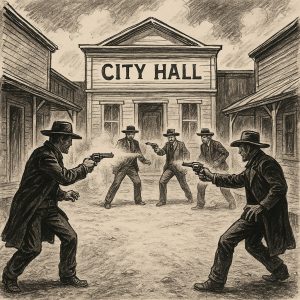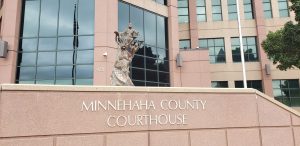State lawmakers enjoy gun-free workplaces while denying cities the same right to protect their employees
Walk into the South Dakota capitol with a gun and you’ll be arrested. Walk into city hall, no problem. That’s the double standard baked into state law.
South Dakota takes a clear stance on firearms in certain government buildings: they’re forbidden in the state capitol and in county courthouses. The reasoning is obvious, public officials, employees, and citizens deserve to conduct the people’s business without the risk of someone brandishing a gun in the middle of a heated debate.
Yet, for reasons known only to the legislature, that same protection does not extend to local government facilities where public passions often run hottest.

Capitol Protections the Rest Don’t Get
Under South Dakota Codified Law 22-14-23, “any person who knowingly possesses or causes to be present any firearm or other dangerous weapon, in any county courthouse or in the state capitol, or attempts to do so, is guilty of a Class 1 misdemeanor.” In other words, no guns in Pierre or in county courthouses (except that those who qualify for an enhanced permit can carry concealed weapons more places). Those are entirely reasonable precautions to prevent tragedy. But the legislature quietly stripped municipal governments from that list years ago, leaving local officials and city employees exposed.
Cities Left Exposed
According to a senior Sioux Falls city official, “The former version of this statute included municipalities, then some years ago the legislature amended it to exclude them. The South Dakota Municipal League has been lobbying for years for an amendment to reinsert municipalities to allow them to exclude firearms from at least those areas. The legislature has refused and has held the line prohibiting municipalities from doing anything about firearms.” That seems especially odd now in the wake of recent shootings of public officials.

Guns allowed in city hall
To make matters worse, the official added, “This last session the legislature took away the city’s ability to prohibit concealed carry by city employees at their workplace.”
A Double Standard on Safety
That means a city employee in Sioux Falls can now legally bring a concealed firearm into City Hall, while lawmakers in Pierre work behind metal detectors in a building protected by armed security. Legislators apparently see the danger in their own setting but not in anyone else’s.
The contradiction could not be more glaring. The same lawmakers who protect themselves from potential gun violence refuse to allow city leaders even the discretion to do the same. It’s not only hypocritical, it’s reckless.

No guns in county courthouses.
Where Passions Run Hottest
“All politics is local,” the saying goes, and in South Dakota, that’s certainly true. City councils deal with zoning disputes, noise ordinances, and neighborhood grievances, the kinds of issues that spark emotional outbursts from otherwise calm citizens. Local officials have every reason to want the ability to keep firearms out of council chambers, just as the legislature does in Pierre.
In an era when political tensions run high, the logic of allowing weapons into local government meetings defies common sense. Across the country, there have been violent incidents and near-misses in municipal settings, from city halls to school board meetings. Most end peacefully, but it only takes one tragedy to remind us why preventive measures matter.
No one is suggesting that South Dakota abandon its strong traditions of gun ownership or self-defense. This is about context and prudence, not ideology. A city council meeting is not a hunting ground, and public servants should not have to wonder who in the audience might be armed during a debate over sidewalk assessments or zoning permits.
Armed and Uneasy at City Hall
City officials sometimes notice armed individuals in city meetings. On a recent occasion in Sioux Falls, an armed person in the audience was reportedly acting in an unusual way. But there is little officials can do other than hope a city security officer is ready to fire back.
Local leaders in Sioux Falls, Rapid City, and elsewhere are asking for nothing radical, just the same basic authority the state already claims for itself. The legislature’s continued refusal to grant that power reeks of double standards and political posturing. It’s as though the right to bear arms suddenly becomes absolute when applied to other levels of government, but negotiable when lawmakers’ own safety is involved.
Act Before the Next Headline
What will it take to correct this imbalance? Must there be another tragic shooting, followed by solemn prayers and promises to “review the policy,” before the legislature admits that local officials deserve the same level of protection it affords itself?
The solution is straightforward: restore municipalities to the protections of SDCL 22-14-23. Allow cities and towns, not Pierre, to decide how best to secure their own public buildings and meetings. Local autonomy should cut both ways. If a city’s elected representatives, in consultation with local law enforcement, believe prohibiting weapons in council chambers is prudent, they should have that right.
Protecting the public’s right to participate safely in civic life should not be controversial. It’s simply good governance. If it’s good enough for the state capitol, it’s good enough for city hall. South Dakotans deserve nothing less.
Thank you Joe. You are spot-on. Your intellect, insight, and willingness to speak are a gift to your fellow South Dakotans. Please stay the course.
Kind regards,
Rich
Here’s a better idea, how about we have effective gun control laws so I don’t have to worry about my security at ANY public space. The word ‘regulated’ is in the 2nd Amendment, which tells me you have the right to bear arms under certain restrictions and regulations. It is time we start restricting how many guns and ammo an individual can have, require passing an extensive background check and have every firearm insured. I support gun ownership, what I don’t support is ignorance. It doesn’t matter if you are standing on the corner of 41st and Minnesota or at the podium at Carnegie, guns are everywhere and we are ALL in danger, in ALL public spaces.
The hypocrisy continues at the collegiate level when they passed a law just last year to allow concealed weapons on state college campuses. Drunk teens never do anything dangerous with weapons that are easily accessible, right? If we trust 18-20 years old to have them on campus then any citizen should be able to carry them into the citizens’ building. A college professor or technical college administrator shouldn’t be scared, so why should our governor and legislators?